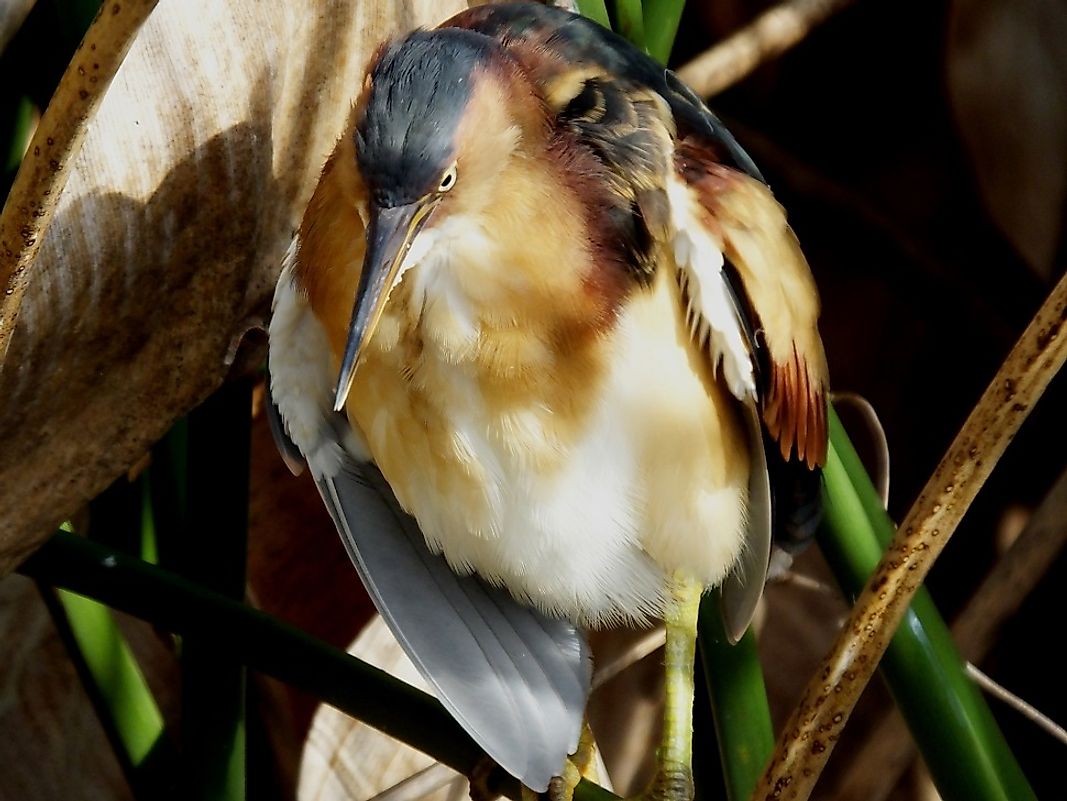Least Bittern Facts: Animals of North America

5. Physical Description
Considered to be one of the tiniest herons in the world, the Least Bittern belongs to the Family Ardeidae, and are known as Ixobrychus exilis in the scientific world. What it lacks in size, however, it makes up for in its furtiveness and stalking ability, making it a very effective, albeit small, hunter. The Least Bittern only measures 14 inches in length, with a wingspan of around 18 inches. It is quite light, and is rather difficult to spot in its natural habitat due to its brown or green coloration. In the rare times when they're seen flying up in the air, these birds' wings may appear light brown or golden yellow, with their sides and necks colored with orange brown or yellow gold hues.
4. Diet
The Least Bittern obtains its food from marshes, lakes, and rivers, often seen perching on top of, or hiding among, reeds and other vegetation growing in the area. Its lengthy bill is well adapted for the jabbing and catching of its prey from the surface of the water. The Least Bittern preys on small fishes such as minnows and perch, as well as minute snakes and crayfishes. Salamanders, tadpoles, dragonflies and leeches complete its carnivorous diet, while coyotes and foxes hunt these birds in turn.
3. Habitat and Range
Huge populations of the Least Bittern can be found in many regions of the Central and Eastern United States, although their winters are typically spent in warmer locations such as Florida and Mexico. Like most herons, they live in freshwater areas where the majority of their food sources also reside, such as rivers and streams. The most significant reason for the decline of the Least Bittern's population is habitat loss, especially that which is caused by water pollution. The Migratory Bird Treaty Act of 1918 has protected these birds since its passing, although the International Union for the Conservation of Nature classifies them as a species of "Least Concern". The Least Bittern is so well colored that it is able to blend rather well with its environment, making it a bit of a challenge to spot in its natural habitat, much less to observe, count, and study. When threatened, they will often opt to flee using their feet to run rather than their wings to fly. They are often heard clucking or cooing in the early mornings, and are so elusive that most bird researchers are only able to hear them rather than see them.
2. Behavior
The Least Bittern is seen frequenting the wetlands where they find most of their food sources rather than soaring across the skies like many other birds. Experts wouldn’t call them aggressive or territorial, and they will often times merely freeze in place with their bills pointed upwards whenever they are caught off guard. Some note their ability to make swaying motions, mimicking the movement of nearby reeds, while others have marveled at these birds’ abilities to compress their bodies when necessary. Because of its rather small size, the Least Bittern is often preyed upon by larger animals, although its furtiveness makes it into a difficult prey to catch.
1. Reproduction
Nest building responsibilities are shared between the male and female members of the Least Bittern species. Nests are constructed above water, usually in well hidden and dense vegetation where their food supplies are most abundant. The female produces about three to seven green or pale blue eggs per year, sequentially laying one each day during some point of the breeding season. Both parents take turns in keeping the eggs warm until they hatch, after which they will jointly feed the nestlings through food regurgitation. The young ones are expected to stay in the nest for seven to fourteen days, although they may do so longer if they are being especially alarmed or threatened.











